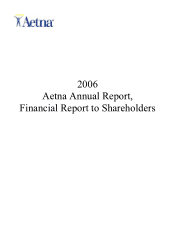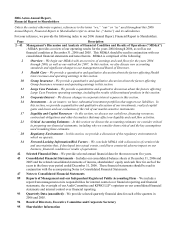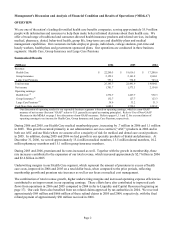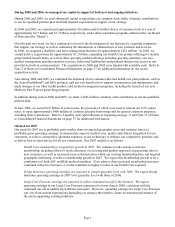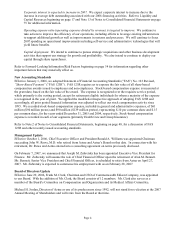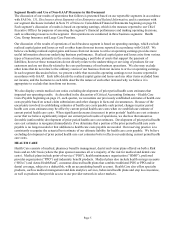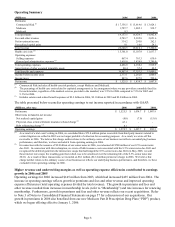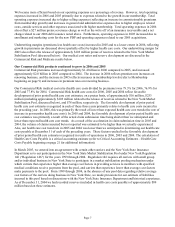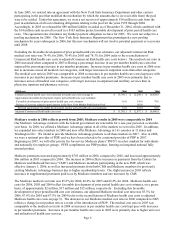Aetna 2006 Annual Report Download - page 7
Download and view the complete annual report
Please find page 7 of the 2006 Aetna annual report below. You can navigate through the pages in the report by either clicking on the pages listed below, or by using the keyword search tool below to find specific information within the annual report.Page 5
Segment Results and Use of Non-GAAP Measures in this Document
The discussion of our results of operations that follows is presented based on our reportable segments in accordance
with FAS No. 131, Disclosures about Segments of an Enterprise and Related Information, and is consistent with
our segment disclosure included in Note 19 of Notes to Consolidated Financial Statements beginning on page 82.
Each segment’ s discussion of results is based on operating earnings, which is the measure reported to our Chief
Executive Officer for purposes of assessing the segment’ s financial performance and making operating decisions,
such as allocating resources to the segment. Our operations are conducted in three business segments: Health
Care, Group Insurance and Large Case Pensions.
Our discussion of the results of operations of each business segment is based on operating earnings, which exclude
realized capital gains and losses as well as other items from net income reported in accordance with GAAP. We
believe excluding realized capital gains and losses from net income to arrive at operating earnings provides more
useful information about our underlying business performance. Realized capital gains and losses arise from various
types of transactions, primarily in the course of managing a portfolio of assets that support the payment of
liabilities; however these transactions do not directly relate to the underwriting or servicing of products for our
customers and are not directly related to the core performance of our business operations. We also may exclude
other items that do not relate to the ordinary course of our business from net income to arrive at operating earnings.
In each segment discussion below, we present a table that reconciles operating earnings to net income reported in
accordance with GAAP. Each table details the realized capital gains and losses and any other items excluded from
net income, and the footnotes to each table describe the nature of each other item and why we believe it is
appropriate to exclude that item from net income.
We also display certain medical cost ratios excluding development of prior period health costs estimates that
impacted our operating results. As described in the discussion of Critical Accounting Estimates – Health Care
Costs Payable beginning on page 21, each quarter, we reexamine our previously established estimates of health care
costs payable based on actual claim submissions and other changes in facts and circumstances. Because of the
uncertainty involved in establishing estimates of health care costs payable each period, changes in prior period
health care costs estimates may be offset by current period health care costs when we establish our estimate of
current period health care costs. When significant decreases (increases) in prior periods’ health care cost estimates
occur that we believe significantly impact our current period results of operations, we disclose that amount as
favorable (unfavorable) development of prior period health care cost estimates. Development of prior period health
care cost estimates is recognized immediately if we determine that a portion of the prior period health care costs
payable is no longer needed or that additions to health care costs payable are needed. Our reserving practice is to
consistently recognize the actuarial best estimate of our ultimate liability for health care costs payable. We believe
excluding development of prior period health care cost estimates better reflects our underlying current period health
care costs.
HEALTH CARE
Health Care consists of medical, pharmacy benefits management, dental and vision plans offered on both a Risk
basis and an ASC basis (where the plan sponsor assumes all or a majority of the risk for medical and dental care
costs). Medical plans include point-of-service (“POS”), health maintenance organization (“HMO”), preferred
provider organization (“PPO”) and indemnity benefit products. Medical plans also include health savings accounts
(“HSAs”) and Aetna HealthFund®, consumer-directed health plans that combine traditional POS or PPO and/or
dental coverage, subject to a deductible, with an accumulating benefit account. Health Care also offers specialty
products, such as medical management and data analytics services, behavioral health plans and stop loss insurance,
as well as products that provide access to our provider network in select markets.

